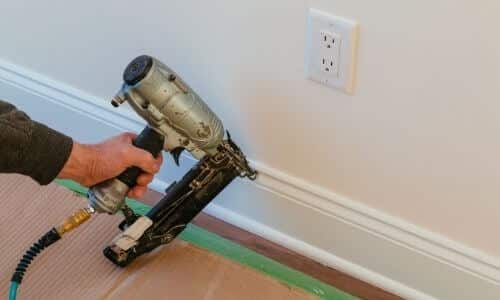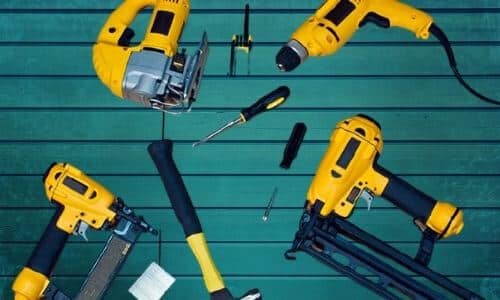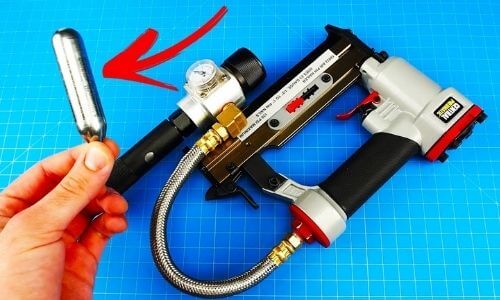We are back with the age-old question – can you use a roofing nailer for siding? You might have a roofing nailer at home, or you may be thinking of buying one. And who can blame you for trying to hit two birds with one stone?
The answer is a bit complicated (spoiler: it’s mostly ‘no’ with some exceptions). And to help you decide, it is mandatory that we talk about the factors that are at play here. We will talk about the distinctions between their usage along with their strengths and weaknesses.
With that being said, let’s move on to the answer.
Roofing Nailers

As you already know, these nailers are mostly used for, well, roofing. However, the term roofing brings some baggage along with it. The first one is that a roofing nailer handles a much heavier workload.
It has to nail through tough materials like asphalt, fiberglass, and so forth. To make that happen, your nailer needs to be quite powerful. Also, since roofing requires different sorts of nails, it differs in that case, too (more on that later).
Siding Nailers

Alright, we will stop stating the obvious bits. These nailers need to nail materials that don’t require a lot of strength to hold them down. And they mostly work with materials like wood, which are so much easier to nail.
Due to that distinction, siding nailers do not need to be as powerful as a roofing nailer. They’re also much lighter and manage to do a better job of siding even when compared to tools such as a framing nailer.
Now that we know the basics, let’s move on to the key distinctions. Don’t miss to check best tool belt for roofing work!
Nail Types

A roofing nailgun uses nails with wider and bigger heads. Not just that, these are usually shorter in length when compared to the ones used for siding. That’s because the wider heads improve the ability to hold components together much better.
Moreover, the wide heads of roofing nails allow you to take them off in the future. The reason behind that is the nailing of your roof will not last forever, and you will have to take them off. Also, the longer nails are only needed for sidings since roofing has to go through thin (although tougher) materials.
There is one issue though, due to the difference in the size of the nails, a lot of roofing nailers might not work well with siding nails. But if yours does, then it passes this barrier.
There’s more, however. You might find that your coil roofing nailer uses coils of nails, which is another obstacle in our path.
Used Materials and Their Rigidity

As you can guess, the distinctions between the nail types are interconnected with different materials. To understand that, let’s talk about their application, lifetime, and rigidity.
First and foremost, the materials we use for siding are not that thick (e.g., wood, hardwood, or vinyl siding). They can be penetrated even with something that does not house a lot of power. The fact that they aren’t very rigid also plays a part in that.
On the other hand, you can see tough materials like fibercement and asphalt. These are much harder to penetrate. Considering the fact that you would expect your roofing to last you a good 15-20 years, it’s only normal that they’re so tough.
And considering how tough they are, roofing nailers housing this much power makes a lot of sense. The power and toughness, however, leads us to the next issue. You can check out what materials do you need for metal roofing.
The Difference in Required Force

The force required is one of the most vital points when it comes to being able to use your roofing nailer for siding.
Roofing nailers don’t have to worry about being able to adjust the power that much. Even though siding nailers are usually pretty adjustable, most roofing nailers aren’t.
These are more of a hit it and go home type of tool. The logic behind it is simple, though. Your usage of the roofing nailers mostly depends on being able to penetrate some very tough materials.
However, siding requires much more delicate handling. While we need the nails on the roofing to hold on to dear life and hang on, sidings are not nailed that tightly.
If you still use a roofing nailer that cannot be adjusted for siding, you would be overpowering the whole thing. That, in turn, would give you not that ideal of a result.
Power Source

The difference between the required power also brings forth the difference between the power sources. Roofing nailers can be pneumatic or battery-powered, or they can use the traditional method.
Battery-powered ones are less powerful; traditional ones are moderate. One could be forgiven for thinking about using a battery-powered roofing nailer for siding. However, trying a pneumatic one would be unwise, to put it mildly. These use compressed air and are way too powerful for anything other than roofing.
The Solution to Overpowering
The solution is somewhat obvious at this point. To use a roofing nailer and still achieve a great result, you need to be able to adjust the amount of force your nailer projects.
Unfortunately, not many roofing nailers come with the ability to adjust the amount of power it uses. If yours does have that ability, then you can get away with using it for siding.
Nevertheless, it still doesn’t guarantee that the end result will be just as good as a siding nailer. And there we have the second nail in the coffin of using a roofing nailer for siding (pardon the pun).
Summing Up the Issues and Solutions

As you can understand from the discussions above, there is a reason why these two tools are kept separated. The first issue would be compatibility, as in ensuring that the nails you are using are okay for the roofing nailer.
After that, the second issue you will face is the sheer power that a roofing nailer houses and the lack of its adjustability. Ensuring the adjustability gives you a path to being able to use it for siding, but most roofing nailers don’t feature it.
So, the chances are that if you already own one, yours doesn’t allow you to customize its output. And if you are buying one, most of the roofing nailers still cannot be adjusted in terms of the power it delivers.
With that being said, our answer, in a nutshell, is that you are better off not using a roofing nailer for siding.
Final Words

Indeed, this was quite an extensive answer for a simple question asking, ‘Can you use a roofing nailer for siding?’ However, the answer isn’t as simple as it seems because of the variables at play. Now that you know what they are, the judgment is up to you.
